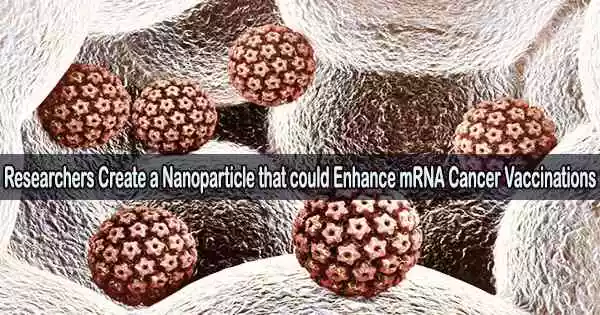Scientists at Johns Hopkins Medicine claim to have created a nanoparticle, a minuscule biodegradable container, that could enhance the delivery of messenger ribonucleic acid (mRNA)-based vaccines for non-infectious diseases like cancer as well as vaccines for infectious diseases like COVID-19.
The results of experiments in mice, which were published on June 20 in the Proceedings of the National Academy of Sciences, demonstrate that a degradable, polymer-based nanoparticle carrying an mRNA-based vaccine was able to travel to the spleen of mice after being injected into their bloodstreams and specifically activate specific cancer-fighting immune cells there.
The researchers also discovered that after receiving an injection of the Johns Hopkins-produced nanoparticles, mice with melanoma lived twice as long and twice as many mice with colorectal cancer lived for an extended period of time.
The researchers also discovered that almost half of the mice’s specialized immune cells had been activated and primed to recognize the specific invading cancer cells. These cells are in charge of identifying and eliminating unhealthy cells like those infected with viruses or cancer.
Nanoparticles made from lipids (a type of fatty acid) are the basis for mRNA COVID-19 vaccines. Such lipid-based, preventive vaccines are typically injected into muscle.
Dendritic cells, which instruct the immune system’s other cells, especially T-cells, to seek out and eradicate cancer cells, are very few compared to the number of muscle cells that can express mRNA and trigger an immune response. By improving the ability of cancer vaccines to deliver their mRNA instructions to dendritic cells, researchers may be able to develop more effective vaccinations for cancer treatment.
The nanoparticle delivery system was able to create an army of T-cells that can recognize cancer-linked antigen. This new nanoparticle delivery system may improve the way vaccines are given for infectious disease, and it may open a new avenue for treating cancer as well.
Professor Jordan Green
Lipid-based vaccinations tend to travel straight to the liver, where they are broken down, making it challenging to inject them into the bloodstream.
“Our goal was to develop a nanoparticle that wouldn’t be sent directly to the liver and could effectively teach immune system cells to seek and destroy the appropriate target,” says Jordan Green, Ph.D., professor of biomedical engineering at the Johns Hopkins University School of Medicine.
Green argues that the mRNA content of the nanoparticle must reach, enter, and be expressed in dendritic cells in order to provide stronger vaccines for infectious disease and for noninfectious disease, such as cancer. After the mRNA is expressed in dendritic cells, it is quickly degraded, and the resulting immune cell response can last much longer after the mRNA and nanoparticles are long gone, say the researchers.
Traditionally, scientists have targeted cells by adding proteins to a nanoparticle that bind exactly, like a lock and key, to the surface of a target cell. However, in laboratory experiments using this strategy, only a small proportion of nanoparticles reach the target cell, and the authors claim that such strategies have manufacturing difficulties.
Green and his team experimented with a variety of materials before settling on a polymer-based vessel to contain a desired mRNA. It is possible to design polymers so that they biodegrade back into smaller molecules inside the body. Polymers are repeating collections of small molecules that form a closely connected chain to build a larger molecule.
The precise engineering of the nanoparticle’s water-loving to water-phobic molecular ratio by Green’s team was crucial to improving the nanoparticle’s ability to encapsulate mRNA and facilitate entry into the target cell.
The nanoparticles were then made to disintegrate swiftly inside the target cell by Green’s team using disulfide bonds. End-capping molecules with an affinity for a particular tissue type were present in the polymers used to make the nanoparticles.
Finally, Green and his team added a ‘helper,’ also known as an adjuvant, to the nanoparticle. The adjuvant helps activate the dendritic cell.
In trials using lab-grown cells, the researchers discovered that primary dendritic cells absorbed the new nanoparticle structure at quantities roughly fifty times greater than mRNA alone. In mice, nearly 80% of cells in the spleen that the nanoparticles reached were the target dendritic cells.
In one series of tests, the scientists employed mice whose immune cells had been genetically altered to light red when the nanoparticle was opened to reveal its mRNA content. In contrast to other immune cells including macrophages, monocytes, neutrophils, and T cells, they discovered that 5% to 6% of all dendritic cells in the spleen successfully picked up, opened, and processed the nanoparticle.
“The immune system is designed to work through an amplified response, where dendritic cells teach other immune cells what to look for in the body,” says Green.
Later studies revealed that compared to mice treated with other nanoparticle formulations and an immunotherapy drug or the immunotherapy drug alone, half of mice with colorectal cancer survived long-term after receiving two injections of the new nanoparticle formulation plus an immunotherapy drug.
The fact that all of the mice with colorectal cancer who had survived for an extended period of time continued to live after receiving additional colorectal cancer cells suggests a sustained immune response that stopped the cancer from spreading.
The researchers also found that 21 days after treatment with the new nanoparticle, 60% of the cell-killing T-cells in the mice were armed to recognize and attack the colorectal cells. Similar to this, around half of the same sort of T-cells were prepared to target melanoma in mice having the disease.
“The nanoparticle delivery system was able to create an army of T-cells that can recognize cancer-linked antigen,” says Green.
“This new nanoparticle delivery system may improve the way vaccines are given for infectious disease, and it may open a new avenue for treating cancer as well,” Green says.
















